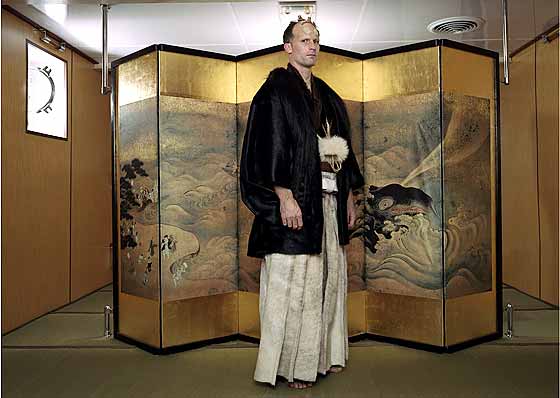
Your mother was an artist. What kind of art was in your home in Idaho?
She was studying at that time. A lot of the things she was doing were done at school. But there were books lying around—Robert Smithson, Joseph Beuys, Eva Hesse.
And then you came to New York to visit her, when your parents divorced. Where did she take you?
She was living in Tribeca, and a lot of the things we would do were downtown. There were galleries in the East Village. I remember going to a Ramones concert.
What kinds of movies did you watch growing up?
Horror films, for sure. The Evil Dead films, the Friday the 13th films, Jaws, The Omen, The Exorcist, The Shining—the simpler, the better. When I started making art, I think the simple-format horror films were a model for me, as a way of making something that blended an object and its environment—if you accept that in some of these stories the antagonist and environment are interchangeable, like the cabin-in-the-woods stories, or the ocean and the shark in Jaws. On a visceral level there was a big difference for me between “wet” characters and “dry” characters. Zombie films never appealed to me because they were too “dry.” I was repulsed by the lack of moisture in those characters.
Besides Ursula Andress, whom you cast in Cremaster 5, which actors made an impression on you?
Bruce Campbell, in the Evil Dead films. It had to do with physical comedy.
What about some of the other genres of film that show up in your work—thirties musicals, silent movies, Westerns?
There was a program on public television that had to do with particle theory and self-organizing systems, and they were taking images from some of those Busby Berkeley [films], and I remember relating to that very much. That might have been when I was in college [at Yale]. As a high-school student I spent quite a lot of time looking at film footage of myself playing football—we’d study these films after we played. They were silent, and they had a very odd presence.
What about art films?
The early video artists—Chris Burden, Vito Acconci, Bruce Nauman, Joseph Beuys, Marina Abramovic—were really influential. In many cases, I never saw the videos. As a student, I had access to still images. The relationship between those secondary documents and the primary event ended up influencing the way I use video: trying to document a primary action and create a secondary form out of it.
What did you read?
I remember liking Where the Wild Things Are very much. But when I started focusing on sports, I read less and less. It was quite natural for me to gravitate toward a physical way of learning, and I think I continue to do that.
Speaking of physical challenges, you’ve long been obsessed with Harry Houdini. What do you consider his most impressive feat?
At the Hippodrome, he made an elephant disappear onstage. And of course the escape through the hole in the ice, which is in that film with Tony Curtis. I think because of that film we have an understanding of how that stunt worked, but I read somewhere recently that they checked the weather records in Detroit, where the stunt was performed, and there was no ice on the river at all at the time.
How did you get to know the work of Richard Serra [who plays the patriarchal architect in Cremaster 3]?
Maybe it was Tilted Arc; I also remember shows at Castelli. I was thinking about the way the body develops under resistance—the way one tears down muscle cells in order to grow more of them. As an athlete, you take that for granted, but I was thinking about the way aesthetic form could develop as well. His thrown-lead pieces were a formalization of that, in a way: a violent action that’s crystallized immediately in the form. And the form is sublime.
How would you describe your relationship to the performing arts?
I’m a real tourist. I was working on Cremaster 3 with those showgirl characters, and I was trying to get my head around that language by going to musical theater—Fosse, the Christmas Spectacular. Opera is potentially the most perfect form, but I’ve never seen one that I really liked. I’m satisfied just sitting in the opera house, not understanding what’s going on.
How about pop music—what did you listen to before you met Björk?
Wendy O. Williams and the Plasmatics. Some of the first shows I saw when I moved to New York were the Butthole Surfers. They were using found medical films, projecting them behind the band—things that were really difficult to watch, like a vasectomy. The way they mixed media I found really compelling.
In “The Order,” from Cremaster 3, you turn the Guggenheim into a kind of video game—are you a gamer?
I played the first wave of arcade games as a teenager—Galaxian, Pac-Man. Donkey Kong is one of those “levels” games I certainly thought about. Recently, I played a game that excited me—Grand Theft Auto. I was editing in San Francisco and driving across the Golden Gate Bridge every day. I’d spent a late night trying to land a helicopter on the top of the bridge, and the geometry in the game is pretty precise. Driving across the bridge the following day felt like a completely different experience. I felt that I had a completely new understanding of its structure.
Drawing Restraint 9
Opens March 29 at the IFC Center; Related Work at Gladstone Gallery from April 7